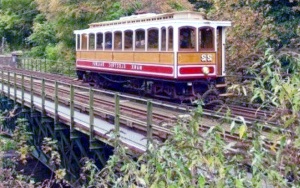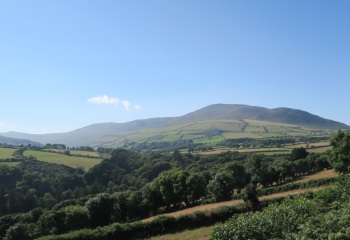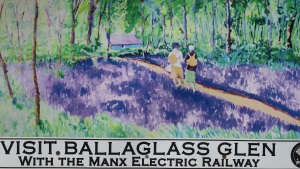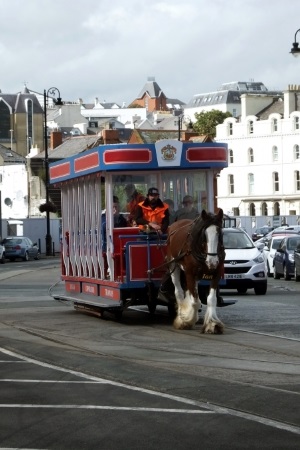Manx Electric Railway Celebrates Its 125th Birthday In 2018

Manx Electric Railway (Manx: Raad-Yiarn Lectragh Vannin) is celebrating its 125 years in operation in 2018. Since its beginning in 1893, it has run along the eastern coast of the Isle of Man (Manx: Mannin). This beautiful and unique tram service operates a variety of vintage Victorian and Edwardian vehicles from the pioneering days of electric tramway development. Work to construct the line began in the Spring of 1893 with the main depot constructed at Port-E-Vada, at the north end of Douglas Promenade (Manx: Shooylaghan Doolish). On September 7th 1893 the regular service was started and continued for 17 days until the 28th for winter closure. It ran as far as the entrance of Groudle Glen (Manx: Glion Ghroudal) on the east coast. One of many glens on the island, it was a popular tourist destination, with paths winding down a wooded valley for about a mile to the sea. Once a small harbour was located here, known by its Norse name of Escadalavik.

The tram service to Groudle Glen was a success and plans were made to extend further to the coastal village of Laxey (Manx: Laksaa). Construction commenced in February 1894 with an impressive viaduct built to span the Groudle river. On the afternoon of 28th of July 1894, the line was formally opened. The entrepreneurs of the time could see potential in continued rail development of this kind. The Snaefell Mountain Railway (Manx: Raad-Yiarn Sniaull) was constructed, using the route of an earlier proposed steam railway to the summit which was not built. The new electrified railway opened on 20 August 1895 and connects with the Manx Electric Railway in Laxey. It climbs from Laxey to the summit of Snaefell (Old Norse: snjœ-fjall/snjó-fall - snow mountain) - (Manx: Sniaull). At 2,036 feet (621 m) above sea level it is the highest point on the Isle of Man.
Plans were then put in place to extend the Manx Electric Railway from Laxey to the north-east coastal town of Ramsey (Manx: Rhumsaa) and construction began in the late summer and autumn of 1897. This involved the further construction of an impressive curved viaduct over the Glen Roy river. By July 1898, the line was completed as far as Ballure (Manx: Balley Euar) at the southern edge of Ramsey, with the official opening taking place on the 2nd of August that year. A bridge was then built across the deep valley of Ballure Glen (Manx: Glion Balley Euar) which allowed the line to be extended into the town of Ramsey which officially opened on the 24th of July 1899.

The is the undulating 17 mile (27 km) 3ft gauge double track line along which passengers can travel today and takes them through areas of great scenic beauty. Some decide to take the tram from Douglas to Laxey and then change to take the connecting Snaefell Mountain Railway to the summit of Snaefell. The journey to the summit of this mountain is a great experience. It is a well-known saying in the Isle of Man that on a clear day seven kingdoms can be seen from the top of Snaefell. To also give their names in Manx they are the Isle of Man (Mannin), Ireland (Nerin), Scotland (Nalbin), Wales (Bretyn), England (Sostyn), Heaven (Niau) and of course the kingdom of Manannán, which is the sea and that of great sea deity Manannán in Gaelic mythology and from where the Isle of Man derives its name. However, the most impressive and attractive part of the Manx Electric Railway line is undoubtedly the section which travels between Laxey and Ramsey. With the mountains on one side and the glens opening down towards the Irish Sea on the other. Many people stay on the railway and take in the views.

The Manx Electric Railway is also a perfect way to travel to walk in some of the Manx glens on the east side of the island. Such as Groudle Glen as already mentioned, but amongst others are Dhoon Glen (Manx: Glion y Dowin) which is the deepest glen on the Island and one of the most beautiful. When descending the wooded valley, clearings give panoramic views down to the Irish Sea. There is a spectacular waterfall called Ineen Vooar (Big Girl) which falls over forty feet in two drops. It is said that the glen is haunted by the ghost of a girl who drowned in its fast flowing river many years ago. A path eventually leads down to a small cove with a shingle beach surrounded by high rocks. Travelling further north the railway also takes you to Ballaglass Glen (Manx: Glion Valley Glass) and there is a tram stop at its top entrance. It has a rock-bedded stream that flows through a wooded glen and the surrounding woods have an abundance of bluebells in springtime.

So happy 125th birthday to Manx Electric Railway and congratulations to those who constructed it and all that now work hard to keep it working. It forms part of a unique railway network on the Isle of Man which includes three heritage railways: Isle of Man Steam Railway, Manx Electric Railway and Snaefell Mountain Railway. This Island’s heritage railway network attracts enthusiasts from across the world and all three railways, which are government owned, are preserved in time and operate with much of the original rolling stock. Other private lines, open to the public, also exist: The Groudle Glen Railway owned and operated by a small group of enthusiastic volunteers and originally opened in 1896. Then there is The Great Laxey Mine Railway which was originally constructed to serve the Isle of Man's Great Laxey Mine, a lead mine located in Laxey. It switched from a horse drawn system to steam in the 1870’s. Also there is a multi-gauge miniature railway known as The Orchid Line running within the Curraghs Wildlife Park in the north of the Isle of Man and operated by the Manx Model Engineering Society. It was established in 1992. Finally, there is of course another unique tram service on the island that deserves a special mention. The horse drawn trams that operate along Douglas promenade, which have operated since 1876.
The Isle of Man does indeed have a very rich transport heritage with several historic railways and tramways still in operation. Preserved in no short measure, by enthusiasts, who over the years have worked and continue to work tirelessly to protect and promote the retention of these unique systems. Our big thanks go to them and they always deserve our support.
- Manx
- English






